Finding color in the garden during the spring and summer is easy, with so many gorgeous flowers in bloom. But did you know you still enjoy attractive, colorful plants throughout the cooler months of autumn, and right into winter?

We link to vendors to help you find relevant products. If you buy from one of our links, we may earn a commission.
A few plants, like short-daylight garden mums, still flower in the fall. But most are finished with flowers by the time cold temperatures arrive.
However, many plants give a dazzling display of autumn (and winter) color via ripe fruits and seed pods that stay on their stems even after the foliage has dropped.
For your continued garden enjoyment after the growing season is over, we’ve rounded up 11 of the best ornamental plants and shrubs for cooler times of year. Join us now for a look at how to add their bright fall colors to your landscape!
Our Favorite Cool Weather Ornamentals for Autumn
1. Chinese Lantern
Chinese lantern (Physalis alkekengi) is a showy ornamental with papery pods that turn a deep orange-red color in early autumn – right in time for Halloween. It is hardy in USDA Hardiness Zones 3-9.
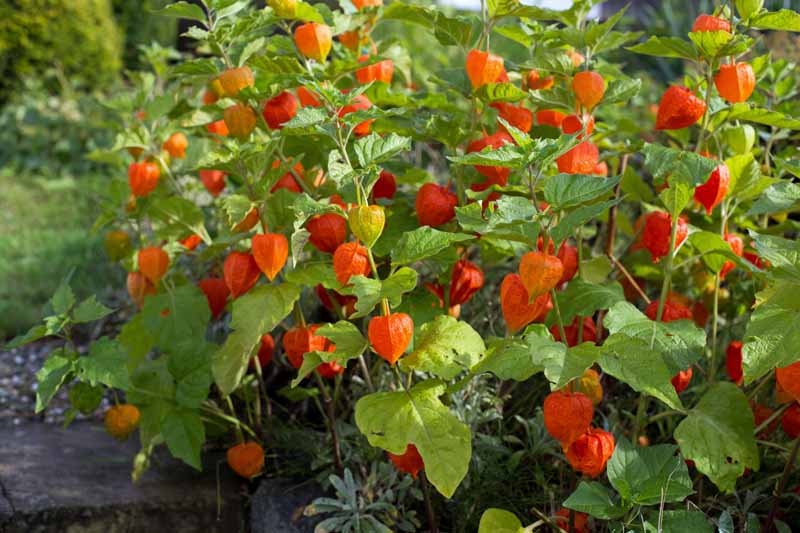
An herbaceous perennial with an upright, clumping form, small white flowers bloom in summer amid medium-green leaves. By late summer, small orange fruits form, and green lantern-like calyces enclose the fruit.
Plants grow 24 inches tall and just as wide, and prefer a full sun location with good air circulation. After plants have finished “blooming,” cut back stems close to the ground.
Chinese lantern can be an aggressive spreader and should be planted where its growth isn’t a concern. Or you can use landscape root barriers to contain spread, and container planting is a good option too. Fruiting stems are attractive in both fresh and dried flower arrangements.
A member of the nightshade family, leaves and unripe fruits are toxic to humans and pets.
Chinese lantern seeds are available from Burpee or you can read more about growing this pretty ornamental plant here.
2. Cotoneaster
Cotoneaster (Cotoneaster) is a deciduous shrub with year-round ornamental appeal that’s a standout in cold temperature gardens.

Pretty pink flowers bloom in spring and form cranberry, orange, or red colored fruits (pomes) in August that last well into winter. And the small, glossy green foliage adds attractive autumn color in shades of bronze, burgundy, and red.
Most species are shrubs that grow from 2 to 15 feet tall with a 3- to 6-foot spread in an upright or mounded form with arching, herringbone branches. And branches will self-root where stems rest on the ground.
Hardy in Zones 4-7, cotoneaster is easy to grow and adaptable to many conditions but does not like the combo of high heat and humidity.
The flowers are attractive to bees, and birds enjoy the berries in winter. Cotoneaster can be used as a specimen plant, as well as in foundation plantings and rockeries. It can be pruned to form low or informal hedges or trained to grow on arbors and trellises. Low forms are also effective for erosion control on banks, slopes, and hills.
Nature Hills has several species available, but for outstanding fall and winter color, our choice is cranberry cotoneaster, available in #3 containers.
Learn more about growing cotoneaster here.
3. Garden Mums
One of the most popular of fall perennials, chrysanthemums have numerous varieties that bloom from late August right into mid-November.
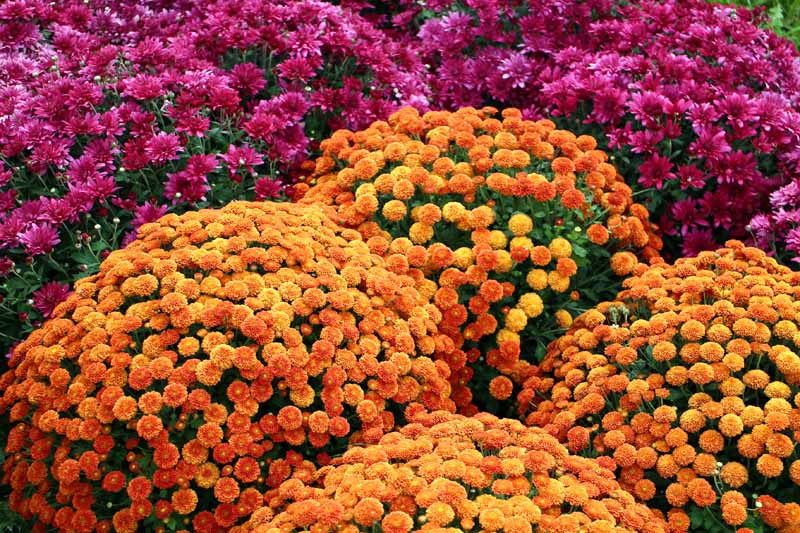
These short-day plants flower in response to the dwindling hours of sunlight in late summer, and bloom with an extensive color palette that includes mauve, orange, pink, red, white, and yellow.
Plants range from 4 to 36 inches tall with a spread of 12 to 36 inches and require full sun for the best flowers. Pinch the tips from mid-spring until mid-July to encourage branching, compact growth, and to stimulate flower production.
Shallow rooted, plants appreciate a mulch in early summer to retain moisture and provide protection from heat. They are hardy in Zones 3-9.
Mums are best where their charm can be appreciated – in beds, borders, containers, and hanging baskets. And because of their shallow root systems, they can be grown in a sunny spot, and then easily transplanted at season’s end to fill in bare spots.
Burpee has a nice selection of garden mum plants to choose from.
Read more about chrysanthemums here.
4. Harlequin Glorybower
Harlequin glorybower (Clerodendrum trichotomum) is another four-season delight. A deciduous suckering shrub, it’s prized for its fragrant, honeysuckle-like flowers that bloom in late summer, and the stunning fruit that follows – a bright blue gumball-like seed enclosed in deep pink, starburst-shaped calyxes.

Plants can grow up to 10 to 20 feet with a similar spread in full sun to part shade locations. And the large, dark green leaves emit an aroma like peanut butter when crushed. Hardy in Zones 7-10, it can be treated as an herbaceous perennial and cut back to the ground in winter.
Attractive to butterflies and hummingbirds, harlequin glorybower makes a striking specimen plant in shrub borders, massed in groups, or growing along woodland fringes.
Buy plants at your local nursery, or pick up seeds on Amazon.
5. Himalayan Honeysuckle
Himalayan honeysuckle (Leycesteria formosa) is a deciduous shrub noted for its clusters of white honeysuckle flowers encased in showy red bracts that bloom from June to September, and the pendulous clusters of plump berries that follow. These ripen from green through pink and burgundy, then finally to a deep, dark purple.

Plants grow 3 to 10 feet tall in multi-caned, upright clumps, and enjoy afternoon shade in hot summer sunshine. Stems are hollow and fast growing, and will freeze to the base in cold temperatures – if freezing doesn’t occur, cut stems back to 6 to 12 inches in winter.
Provide a thick mulch in regions with cold winters for new stems to appear in spring. Himalayan honeysuckle is hardy in Zones 7-9.
Flowers are mildly fragrant and attract hummingbirds, and birds enjoy the berries in fall and winter. Use Himalayan honeysuckle grouped in small stands in woodland gardens, or as a stand-alone specimen.
Read more about growing Himalayan honeysuckle here.
6. Oregon Grape
Oregon grape (Berberis aquifolium, formerly Mahonia aquifolium) is an evergreen shrub with an upright habit that provides four seasons of color. Fragrant yellow flowers bloom in spring and clumps of edible, blueish-black berries form in summer and hold until winter.

Plus, the glossy, dark green foliage emerges in spring with rosy tones, then turns burgundy in fall and takes on bronze hues in winter.
Plants grow 3 to 6 feet tall and 5 feet wide, and the berries look like clusters of small grapes amid the holly-like foliage. Plants prefer a part shade location and produce the best berries when more than one plant is grown in the garden, for cross-pollination.
Oregon grape is hardy in Zones 5-8. It is attractive planted in shrub borders, foundation plantings, in small groups, and in shade or naturalized gardens. Pick up plants at your local garden center, or shops that specialize in native North American plants.
Get tips on caring for Oregon grape holly here.
7. Snowberry
Snowberry (Symphoricarpos) is a rounded, deciduous shrub with clusters of tiny pink flowers that bloom in mid-summer, and form round, green berries that mature to white or pink. Attractive on bare stems, they last throughout winter as birds generally find them unappealing.

Plants typically grow 3 to 6 feet tall and just as wide. Adaptable to a range of soils, snowberry prefers a full sun location for the best berry production. Prune as needed in late winter or early spring.
Use snowberry in shrub borders, loose hedges, screens, and in open naturalized areas. Due to their suckering habit, they’re also effective when used for erosion control on steep banks and slopes.
Nature Hills offers two types snowberry. ‘Magic Berry’ has delightful pinky-purple berries throughout fall and winter, and ‘White’ has pure white berries and handsome blue-green foliage.
Find tips on caring for snowberry bushes here.
8. Rose
Throughout fall and winter, roses (Rosa) can provide a beautiful display of color with their seed pods, or hips. Hips are ovate, round, or urn-shaped, and brilliant, long-lasting shades of burgundy, orange, red, or yellow brighten bare branches throughout the dark, cold months.
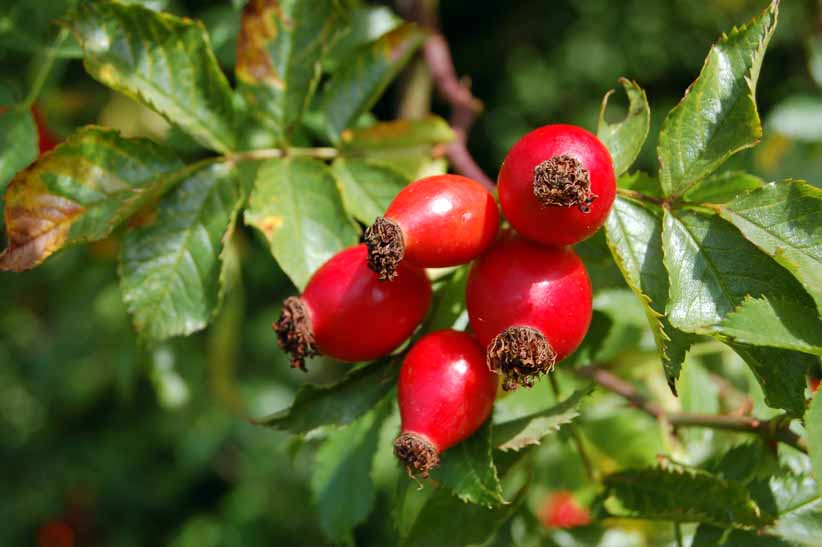
Species roses provide the plumpest hips, while rambling and climbing roses give fantastic cascades of colorful pods. To produce a good supply of hips, stop deadheading spent blooms in mid-summer to allow seedheads to form. Hips start out green, then take on more autumnal hues as temperatures drop and days shorten.
Use as specimen plants, in beds, hedges, screens, and on arbors or trellises. Colorful hips can also be cut for indoor floral arrangements or used in wintertime decorative arrangements, and holiday decor like swags and wreaths.
A few suggestions for colorful hips are:
- Rosa canina – The wild dog rose is a scrambling climber that produces egg-shaped hips that provide a fantastic transition of colors – from green to burgundy throughout summer, and finally, bright red in September.
- filipes ‘Kiftsgate’ – A substantial rambler, ‘Kiftsgate’ produces abundant trusses of orange-red hips.
- moyesii – Hips have a unique urn shape and range in color from pinky-yellow to intense, fiery red.
- rugosa – The beach rose produces delightful round hips the size and color of cherry tomatoes, typically forming while still in flower.
- spinosissima – The Scotch rose is useful as a low hedge and develops wonderful spherical hips in deep purple.
Nature Hills has a large selection of roses to choose from in #2 and #3 containers.
Read more about growing roses here.
9. Russian Sage
A woody perennial in the mint family, Russian sage (Perovskia atriplicifolia) features whorls of tubular, pale blue flowers in tall, 12- to 15-inch tiered panicles.
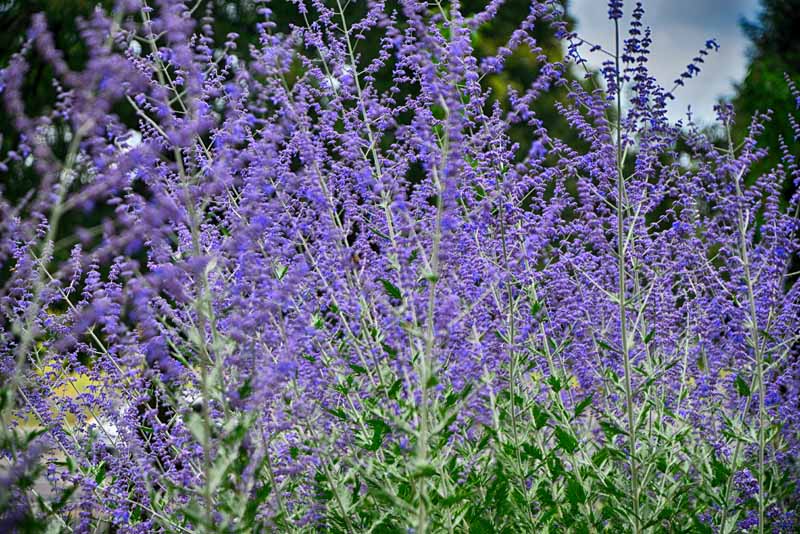
Flowers grow on densely branched stems, and bloom from July to October. The fine-textured foliage is aromatic when crushed and has a frosty, grey-green color.
Russian sage needs excellent drainage and full sun for best performance, and can be cut back almost to the ground in late winter when new growth first emerges. Plants grow 3 to 5 feet tall with a 2- to 4-foot spread, and are hardy in Zones 4-9.
Rabbit, deer, and drought tolerant, it’s well suited for use in mass plantings, as a specimen, for middle-tier interest in mixed perennial beds, in naturalized settings, and in xeriscapes.
You can purchase Russian sage seeds online from True Leaf Market or read more about growing it here.
10. Sweet Autumn Clematis
A vigorous, twining vine with prolific growth, sweet autumn clematis (Clematis terniflora, formerly C. paniculata) is a fragrant fall-bloomer with pretty, star-shaped flowers and a citrusy scent.
Flowers bloom from late August into October, and give way to elegant, plumed seedheads that last into winter.
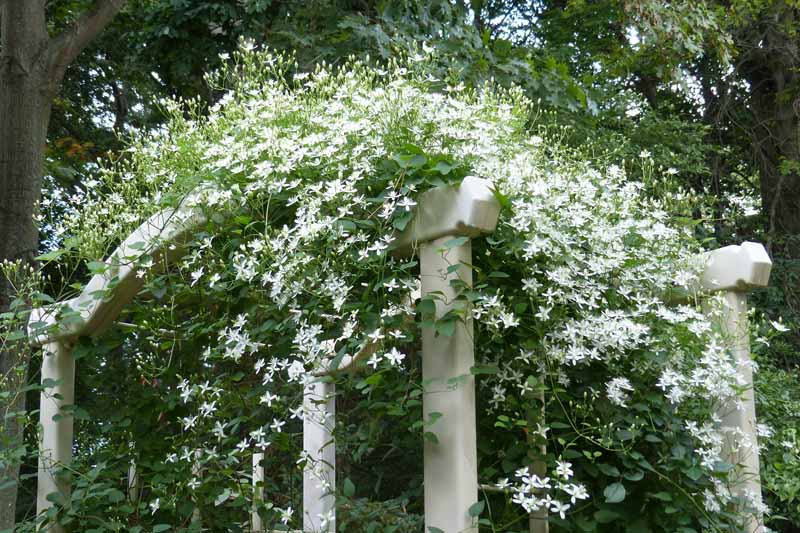
Unlike most species of clematis, C. terniflora grows equally well in shade or sun, and with support, climbs up to 20 feet in length with a mature spread of 8 to 10 feet. Flowers grow on new wood and plants should be pruned hard after flowering, in late autumn to early spring.
Sweet autumn clematis is well suited for growth on arbors, fences, pergolas, posts, and trellises, sprawling as a ground cover, or to hide eyesores like rock piles and decaying stumps.
You can purchase one-quart container plants of sweet autumn clematis at Nature Hills.
11. Winterberry Holly
Winterberry (Ilex verticillata) is a deciduous holly that features bunches of showy, bright red berries in late summer that last throughout fall and winter. Inconspicuous white flowers bloom in late spring, and if pollinated by a nearby male plant, berries form in late summer amid dark green leaves.
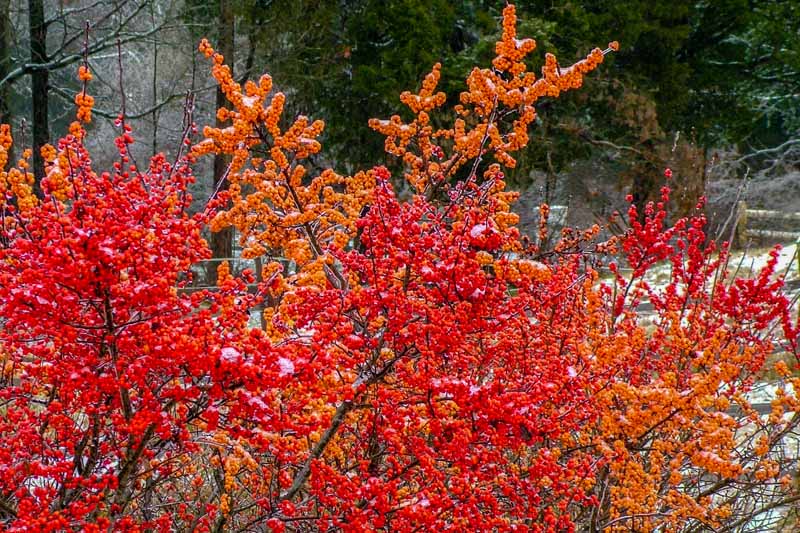
They feature an upright, rounded habit and grow 3 to 12 feet tall. Species plants often sucker into large thickets, while cultivars have a more restrained spread.
Bog lovers, they have a good tolerance for poorly draining soils. And because they are dioecious, female flowers need to be fertilized by a nearby male to produce the attractive berries – one male will pollinate up to 10 females.
Winterberry makes a striking impact when mass planted in snowscapes or cold-frosted, and it is well-suited for large containers, perennial beds, or naturalized areas – anywhere its bright berries can be enjoyed. The fruit-laden bare stems make spectacular decorations in the garden and home, and may be used extensively during the winter holidays.
Cultivars typically produce larger flowers and bigger clumps of fruit than species plants. Nature Hills offers ‘Red Sprite’ in #3 containers – a compact plant that grows 2 to 3 feet high, with females that produce a profusion of berries for year-round interest.
And you can also find winterberry seeds on Amazon.
Read more about growing winterberry holly here.
Cool Plants for Cold Temperatures
Armed with your list of the 11 best ornamental plants for fall gardens, will you be adding some of their lively color to your autumn landscape?
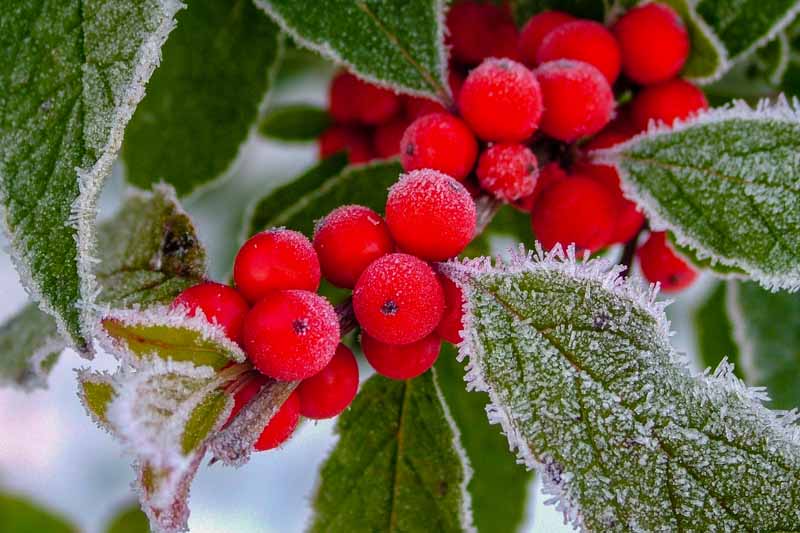
From herbaceous perennials to shrubs and vines, there are plants suitable for every hardiness zone and garden. And many can be enjoyed indoors in floral arrangements or added to your holiday garden decor as well.
Any questions or comments about these plants? Drop us a note in the comments below. And if you enjoyed this guide, here are a few more that you’ll find useful for adding late season color:
- The 15 Best Woody Shrubs for Fall Color
- The 15 Best Perennials for Fall Color
- 15 of the Best Annuals for Vivid Fall Color
- How to Choose Flowering Annuals for Cold Climates
© Ask the Experts, LLC. ALL RIGHTS RESERVED. See our TOS for more details. Uncredited photos: Shutterstock.

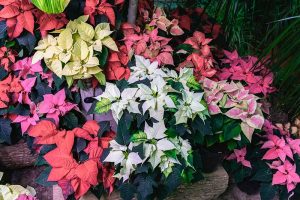
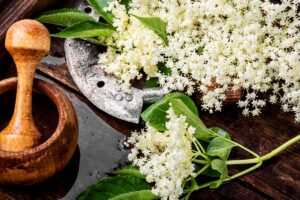
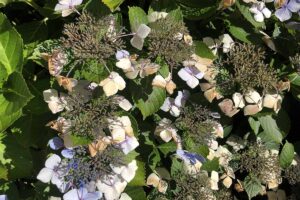
Are any of these plants native to the United States?
Several are native to North America Andrea – Oregon Grape, Snowberry, some Roses, and Winterberry are all indigenous to the USA.
Thanks for asking!
Are any of these known to be invasive species?
None are on the USDA invasive species list.